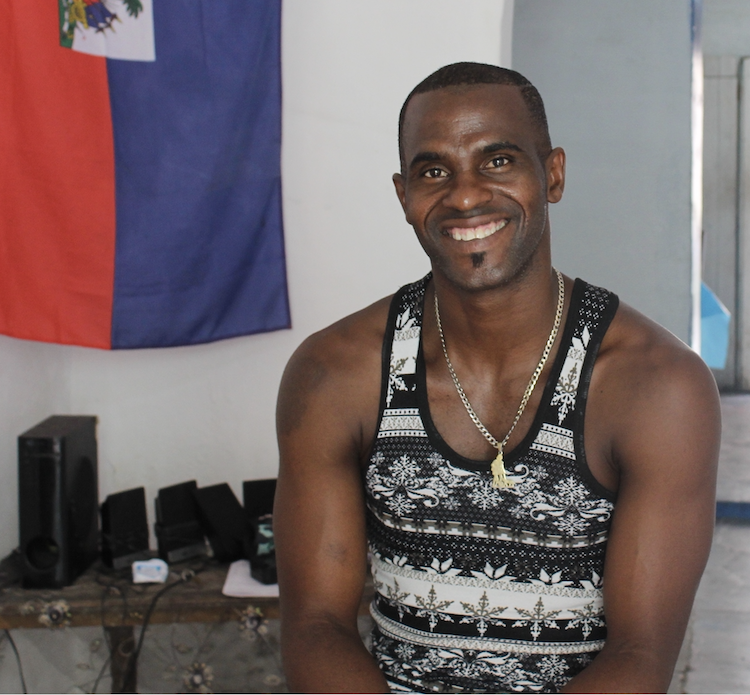“Salsa dancing is a powerful way to communicate to society,” said 36-year-old Leysvel. He learned to salsa when he was 22, and now he is a professional who has been teaching for several companies opening up many travel opportunities throughout Cuba, Mexico and Europe. Learning popular Cuban dances has allowed him to accumulate many different abilities, movement, coordination and confidence, developing his self-improvement. To Leysvel, dancing means “independence, competitiveness and the best channel to express myself.”

Leysvel is a professional dancer in Trinidad | Ellysse Horniblow
La Canchanchara in Trinidad, Cuba, is his favorite dance floor. Many locals and tourists can get involved and build a passion for dance there. The atmosphere is perfect for letting loose, and really enjoying yourself. “I feel like I float when I dance here,” he insists. His electric and driving energy powered the floor as he demonstrated Casino (Cuban-style salsa).
Traditionally, Casino is danced as an interplay between a male and female feeling the music. A Casino dancer often integrates movements, gestures and extended passages from other dances. Leysvel danced with a local woman from Trinidad, and though they did not know each other, the graceful and fluid movements characterised the moment as sensual and romantic; the years of history and emotion was certainly reflected. It was very obvious that his love for dance was exceptionally strong.
Salsa is a dance and a musical style with deep Caribbean and African roots. The origins of salsa date back to the 1900s in Eastern Cuba, where musical elements and rhythms from various sources were combined. Cuban son and Afro-Cuban rumba are the two main styles that were merged to create salsa, with a diverse range of musical instruments to produce the foundation of the rhythm. The dance’s beat is commonly recognised for being beguiling, sensual, and simple to learn, however, very difficult to master. It is seen as a passionate dance with lots of side movement and synchronised turns.

Salsa dancer teaching students | Ellysse Horniblow
The stories that the dancers tell through the movement of their bodies are so powerful and it is what makes it so captivating. People who are learning to Salsa generally wear comfortable clothing, however, at dance shows, the costumes worn by dancers which are usually brightly coloured and flirty. Cuban salsa dancing can look a little daunting for beginners as it has a very complex feel to it with the fast-paced movements. The basic rhythm consists of taking three steps for every four beats of music. The resulting effect is a catchy pattern that alternates between weak and strong measures. This contributes to a compelling, energetic sensation which is why the music is generally so danceable. It is more about getting yourself swept up in the feel of the music.

Leysvel teaching students to salsa dance in Trinidad | Ellysse Horniblow
“When I dance, I forget everything and focus on how it makes me feel–it is really liberating,” said Ricardo. As a local who likes to dance, his eyes lit up with excitement describing the fine art to salsa dancing. At the age of 7, Ricardo and his older brothers were taught to dance by their family. Once he learned to listen to the music and find the connection, his passion grew. After a stressful day of work, he loves to place all of his energy into salsa dancing with his partner. “It makes me feel so free.”
Casa de la Musica (The House of Music) is one of Ricardo’s favorite places to listen to live music and dance. It opened in 1996 and, to this day, is still one of the classic venues in the city. It belongs to the Company of Recordings and Musical Editions (EGREM). This place is an alfresco (open air) affair that congregates on the sweeping, cobbled staircase beside the Iglesia Parroquial church off Plaza Mayor. The location is enjoyed by locals and tourists, especially in the evening when the salsa dancing begins.

Staircase at Casa de la Musica in Trinidad | Ellysse Horniblow
Dancing is extremely important to Ricardo and his family, as a way to “express feelings and form a connection with people and music.” He has carried on many cultural traditions to his children and grandchildren and hopes that they will continue to pass it down to future generations. The intent is to embrace the culture, the community, and invite others to be part of this growing family.
Taberna La Canchanchara
- Address: 90 Calle Real del Jigüe, Trinidad 62600
- Open 24hrs
Casa de la Musica
- Address: Calle Cristo, Trinidad 62600
Edited by Julissa Ramirez.

